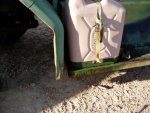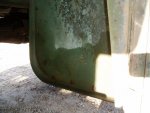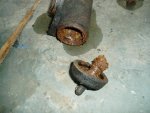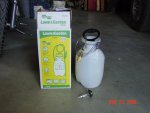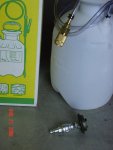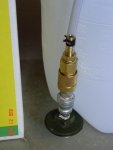Barrman
Well-known member
- 5,459
- 2,178
- 113
- Location
- Giddings, Texas
I have noticed what seems to be an oily film on my drivers side running board and inner fender the last week or so. I have a plastic 5 gallon jug of fuel sitting there and figured it had a pin hole leak or something. I also had a little mess on the frame rail above the axle. I figured that was just residue from cleaning out the secondary filters, a slight leak on a return line I fixed a month ago and possibly from a retouting of the flame heater supply line to the injector return lines once the heater injector started leaking. To put it another way, I ignored the obvious signs.
I moved the truck Wednesday so I could change the oil and install a Jatonka spin on oil filter set. My brake pedal was soft. I checked the fluid and it was down just a little. I topped it off thinking the vent line might have been leaking a little since it wasn't all the way tight like I thought I had left it. The pedal was hard when I tried it. Again, I ignored the now obvious signs.
Before work Thursday, I was up early because the brake fluid thing basically wouldn't let me sleep. I used a flash light to look at the inside of all the tires and found the problem. Drivers side front wheel cylinder was leaking. The tire was throwing the slimy compared to DOT 3 BFS on the fender, frame rain and running board. I mis took it for diesel residue. Anyway, I pulled the wheel cylinder and found a mess. Rebuilt version put in and all is well. The pictures below show the reisdue I should have recognized and the bad wheel cylinder.
I moved the truck Wednesday so I could change the oil and install a Jatonka spin on oil filter set. My brake pedal was soft. I checked the fluid and it was down just a little. I topped it off thinking the vent line might have been leaking a little since it wasn't all the way tight like I thought I had left it. The pedal was hard when I tried it. Again, I ignored the now obvious signs.
Before work Thursday, I was up early because the brake fluid thing basically wouldn't let me sleep. I used a flash light to look at the inside of all the tires and found the problem. Drivers side front wheel cylinder was leaking. The tire was throwing the slimy compared to DOT 3 BFS on the fender, frame rain and running board. I mis took it for diesel residue. Anyway, I pulled the wheel cylinder and found a mess. Rebuilt version put in and all is well. The pictures below show the reisdue I should have recognized and the bad wheel cylinder.
Attachments
-
76.4 KB Views: 355
-
63.8 KB Views: 434
-
86.2 KB Views: 462



